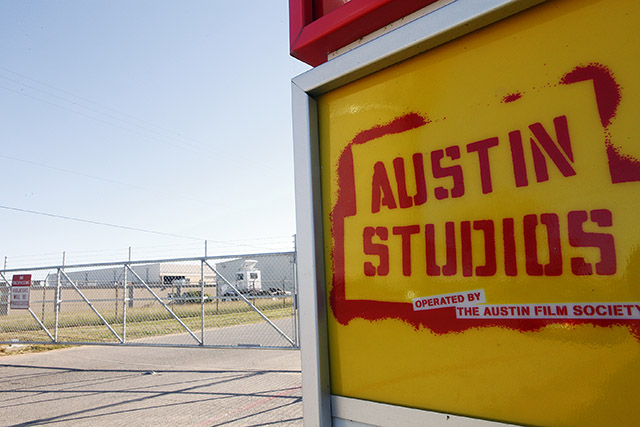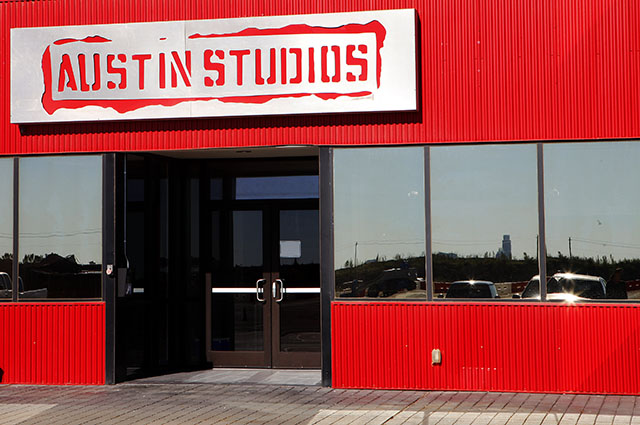A Meaningful Election for Austin Studios

Austin Studios acquired the Texas National Guard Armory site in 2009 and plans to start renovating it in late 2012. Photo by Oscar Ricardo Silva.
By Kelli Ainsworth
For Reporting Texas
Instead of a large, flashy marquee proclaiming its presence, Austin Studios has a small sign stuck in the ground that resembles those advertising garage sales or piano lessons. At its chain-link gate, visitors call the front office from a small box and are buzzed in. There is no imposing security entrance with an intimidating uniformed guard who checks visitor names against an official list. At the moment Austin Studios, located off a remote, dilapidated section of 51st Street, doesn’t project an aura of Hollywood glamour.
So it’s no surprise that Austin Studios and the Austin Film Society, the organization that runs the studios, hope to improve their facilities and expand their operations with money from an upcoming City of Austin bond election. But they don’t want a Hollywood makeover. While they hope to increase Austin’s clout in the film industry, they say they would use the additional money to help nurture local, emerging talent.
The $9.5 million bond item that will go before Austin voters on Nov. 6 is part of Proposition 18, a $13.4 million package devoted to improving and renovating local libraries, museums and other cultural institutions. Rebecca Campbell, executive director of Austin Studios, said that if the bond passed, the money would be used to renovate the National Guard armory, an adjacent property that the group obtained from the city in 2009. The Austin Studios plans to use the 73,000 square feet of additional space to build sound stages (it currently has five) and add more offices for artists and businesses tied to the film industry.
Austin Studios began in 2000 as a joint venture between The Austin Film Society, which is headed by the director Richard Linklater, and the City of Austin. The city provided the Film Society with 20 acres that had been a part of the now-defunct Mueller Airport. Austin Studios received $5 million in bond money in 2006, which it used to fund its first wave of expansion and improvement. Austin Studios has been a part of such movie productions as “True Grit,” “Stop-Loss” and “Miss Congeniality” and the television series “Friday Night Lights.” The studio is currently the production site for the ABC Family television series “The Lying Game.”
Leslie Pool, a member of the advisory board that prepared the bond proposals for the City Council to consider, cites Austin Studios’ filmography as a reason she supported approving the studio’s second public financing in six years. “They have a solid financial return on investment,” Pool said. “Bottom line: I have zero worries about public dollars going to finance this proposal.”
Campbell said the goal of upgrading the studios isn’t about transforming Austin into a mini-Hollywood. She hopes the money will allow them to create more opportunities for local artists. “The vision for Austin has to do with developing home-grown talent while still keeping a placeholder to attract out-of-town production,” she said.
Supporters of the Austin Studios bond item say that movie and television productions stimulate the local economy because films also use catering, florists, lumber, hotels and restaurants. Campbell says the production crew of “The Lying Game” numbers 125, many of whom are local homeowners. “This is work that employs electricians and carpenters and caterers and folks in Austin that are good living-wage jobs,” says Jeb Boyt, a member of the Bond Advisory Task Force.
But not everyone in Austin believes the bond item is worth it. The Travis County Republican Party is opposing all of the bond propositions, in part because they believe that the money may not be spent on what’s actually been proposed. They’re also concerned that the cost of the bonds will be passed on to Austin residents. “Austin’s bond indebtedness is already too high, and ultimately all these bond propositions will lead to tax increases,” said Roger Borgelt, vice president of the Travis County Republican Party. “They may not immediately, but they will ultimately.”
Even if the bond passed, there’s a limit to how much the film industry can grow in Austin. Because the state of Louisiana provides generous incentives and tax breaks, the Shreveport-Bossier City area in Northern Louisiana has come what Austin hopes to be.
Arlena Acree, the director of film, media and entertainment for the City of Shreveport, said that since 2008, 73 films and TV shows, with budgets totaling more than $600 million, have been shot in the Shreveport area. This year, 18 movies and shows have been filmed there.
Acree said that filmmakers are drawn to shoot in Shreveport because they can take advantage of the state incentives offered to film productions while staying out of the hurricane zone. Also, because Shreveport (population 200,000) is a smaller city with good infrastructure, it’s easy to get around — people can get from one point in the city to another in 15-20 minutes.
Because Austin has so much traffic, she said, the Texas capital “could never do what we do.”
As long as Texas lags behind Louisiana in state-level incentives, Campbell said, Austin will have trouble competing with Shreveport in spite of its own strong infrastructure, talented local crew and quality of life that might appeal to filmmakers.
“Shreveport is dominating,” she said. “I would say Shreveport is kicking our ass. If Texas was offering the kind of incentive that Louisiana was offering, there would be far more production in Austin than there is in Shreveport.”
